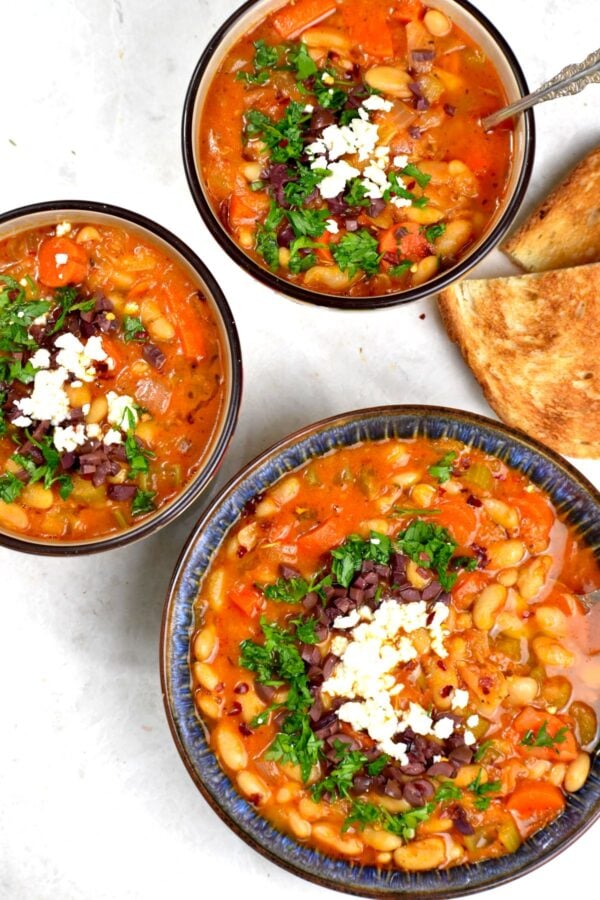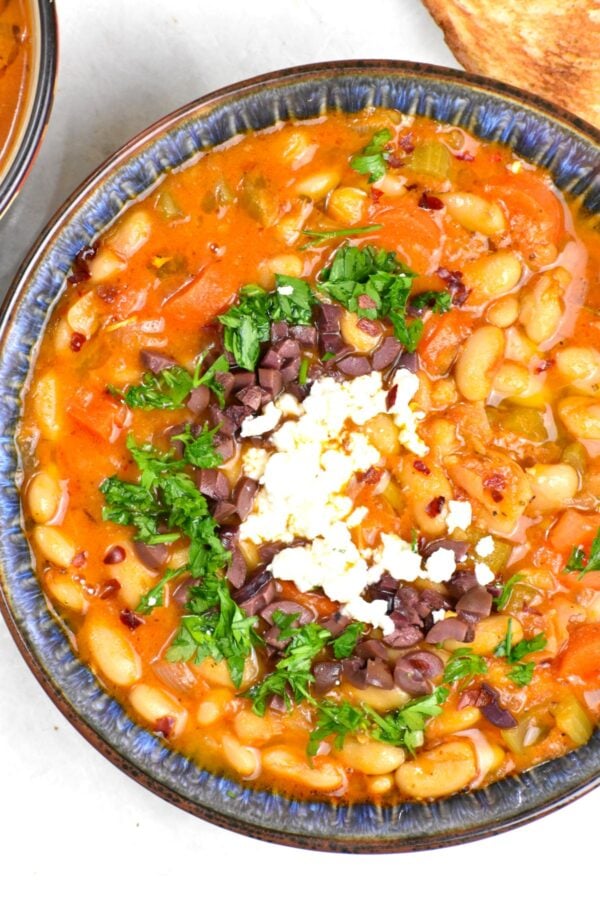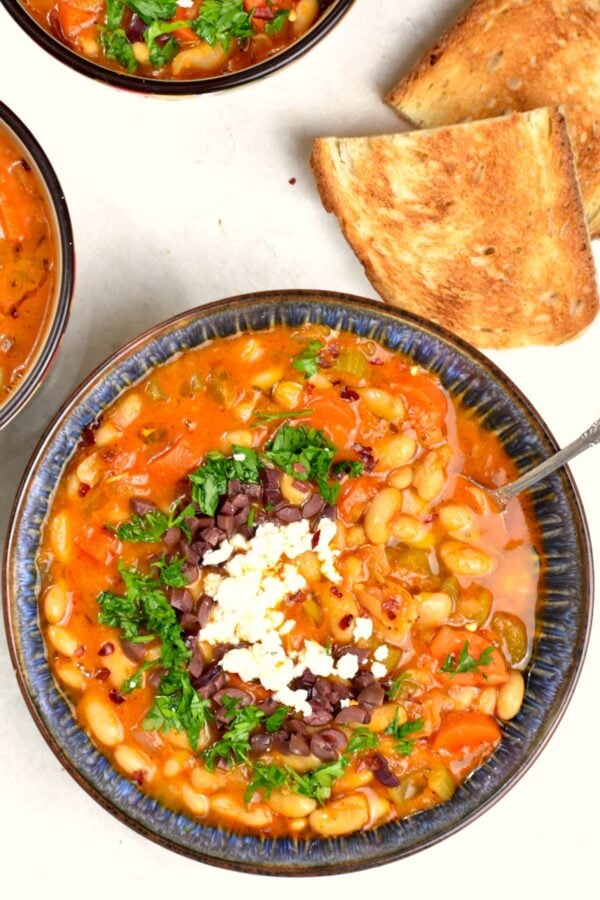This hearty white bean soup is filled with everyday aromatics like onions, garlic, tomatoes, and celery. But the real magic happens when I add a generous drizzle of olive oil at the end. The result? Unbelievably creamy, velvety bean deliciousness that I absolutely adore. It’s no wonder it’s often called the national dish of Greece. Surprised? A humble bean thing can be as equally revered and adored as their popular moussakas, souvlakis and tzatziki. Yes. This is not something you might find in high end Greek restaurants, and very few people outside of Greece are even aware of its existence. But this is what fed the Greeks for generations. Every household has their typical traditional way to start the winter… with a big pot of Fasolada!
What is Fasolada?
A pot of bean soup simmering for hours is a classic in many cultures, dating back to ancient times. It’s a healthy and economical way to feed the family. Over time what was considered “poor man’s food” has gained respect that it deserves in modern times. Fasolada, or Fasoulada, is a Greek soup of white beans, vegetables and olive oil and can be found all over the Mediterranean and neighboring Arabic and Levantine regions, of course with different versions and names. It might be known as fagiolata in Italy, Feijoada in Portugal and Brazil, Fasole in Romania, Fabada in Spain, Kuru Fasulye in Turkey or Fasoulia in many Arabic countries. The name Fasolada comes from the word ‘fasoli’, meaning beans. Beans and pulses play an important role in the Greek kitchen. Traditionally Greeks would eat beans at least twice a week, as they are a cheap and accessible source of non-animal protein. Fasolada is either white in color and made zingy in the end with tons of lemon juice and some herbs, or it’s red from the addition of tomatoes in some form. It’s very popular during lent, as most of the time it’s made without any meat, though adding meat along with beans is not that uncommon. Fun fact: It has an ancient and mythical existence. Fasolada was the soup of the Greek gods! The myth is that at the annual festival honoring Apollo, this soup was served to the festival attendees and to Apollo himself. The Greek gods vanished over time, but Fasolada lives on…
What kind of beans to use
Any white beans like cannellini, navy, or great northern beans work great for my Fasolada. Sometimes, I prefer using dry beans, just like the Greeks do. They need to soak in water overnight, or at least 8-10 hours, before cooking. But today, I’m using canned cannellini beans to show you how quick and easy this soup can be, without sacrificing any flavor. It’s a convenient shortcut that still delivers all the deliciousness of the classic dish.
Ingredients Needed
I am going to make Fasolada with tomatoes today, here is what you need…
White beans Onion – Spanish or white, diced. Garlic – Thinly sliced. Celery – Chopped. Carrots – Chopped. Tomatoes – I am using both crushed and tomato paste, to give extra depth and flavors. Vegetable broth – You can opt for chicken broth too. In a pinch you can use just water. Herbs & spices – Oregano, rosemary, red chili flakes and bay leaves. Extra virgin olive oil Salt – to taste. Garnishings – Parsley, olives (you can use black or kalamata), feta cheese, red chili flakes, extra virgin olive oil.
Fasolada Recipe
When I’m using dry beans, I let them soak overnight in water with a little salt added. The next day, I discard the water and boil them in fresh water until they get soft. It usually takes about 30-40 minutes, but it can vary depending on how fresh they are. I’ve noticed that older beans tend to take longer to cook, especially if they’ve been sitting in my pantry for a while. Once they’re cooked, I drain them and set them aside to use in my Fasolada. Today, I’m using canned cannellini beans to speed up the process of making Fasolada. Trust me when I say, the results are just as delicious, especially when I add some great flavor enhancers. You wouldn’t even realize that this amazing bean soup was made with canned beans. I love making things a bit easier without sacrificing flavor. So, I simply drain the liquids from the canned beans and leave them in a colander until they’re ready to go into the pot. It’s a simple shortcut that still delivers fantastic taste! I start by heating some extra virgin olive oil in my soup pot over medium-high heat. Then, I add chopped onions, carrots, celery, sliced garlic, and salt, and sauté them for about 3-4 minutes. Next, I stir in the tomato paste and cook it for another minute. After that, I add either tomato sauce or crushed tomatoes, along with the herbs and spices, and combine everything well. Once that’s done, I mix in the canned beans and broth. I bring it all to a low boil, then reduce the heat and let it simmer for about 30-40 minutes until the carrots are tender, stirring occasionally. Now for the secret part to make it creamy and velvety. I take out about a cupful of beans and mash them in a bowl with a spoon until they form a paste. Then, I stir that back into the pot. This is where the magic happens. My soup starts to look thick and luscious, with a wonderfully creamy texture. It’s a simple trick that takes the soup to a whole new level of deliciousness! Now the Greeks end their bean soup with plenty of good olive oil. I am using good quality extra virgin olive oil. I swirl that around in the pot and end up with velvety mmmlishiousness.
What to serve it with?
Variations
There’s another popular version of Fasolada that’s white instead of tomato-based. It’s pretty much the same recipe, but instead of tomatoes, it gets a good dose of lemon juice and lemon zest at the end. Sometimes, I have a hard time choosing which version I prefer. They’re both so tasty in their own unique way! If I want to make my Fasolada even heartier, I add some meat, like delicious sausage or even beef or pork mince. If I’m using sausage, I just brown them up first before adding them to the soup. For beef or pork mince, I stir fry them with a bit of salt, pepper, and my favorite seasonings before they go into the soup pot. It’s a simple way to add some extra protein and flavor to the dish! Instead of making it soupier, make a drier version with very little water. Play with beans. Think navy, black eyed peas… even try the same recipe with various or mixed lentils.
Alpana’s Tips
Slow Cooking: When making bean soup like Fasolada, I find that slow cooking really enhances the flavors. Letting it simmer for long time allows the ingredients to meld together beautifully. Herbs and Spices: Don’t be afraid to experiment with different herbs and spices to customize the flavor of your Fasolada. I love adding a combination of dried oregano, rosemary, and thyme for a Mediterranean flair, but feel free to use whatever herbs and spices you prefer. Mashing Beans: When I mash a cup of beans before adding them back into the soup, it thickens it up and gives it a creamy texture. I make sure to mash them thoroughly to get the perfect consistency. It’s a step that really enhances the flavor and texture of the soup. Adding Olive Oil: I always add lot of the olive oil at the end and whisk it into the soup. It gives it a richer flavor. I make sure to whisk it well to spread it evenly throughout. It really amps up the taste and makes each bite more flavorful. Garnishes: Don’t forget to garnish your Fasolada with fresh herbs, a drizzle of olive oil, and maybe some crumbled feta cheese for an extra touch of flavor and freshness. Fasolada… it’s a great meal choice if you are turkeyed out from the holiday and looking for something lighter. It’s a healthy, smooth, completely plant based yet protein-packed hearty meal. This is the kind of thing where you just throw everything together and let it perform its magic. Soon cold balmy nights are coming to some of you, pin or bookmark this great Greek winter warmer for the upcoming days. Subscribe to GypsyPlate for some great stews and soups coming directly to your email. Time to go to my steaming bowl of Fasolada (that we reheated after the shoot… that’s always the case with food bloggers). Chow time! Pass me that bread, honey!!
Fasolada, in our Gypsy Bowl… enjoy!
Try these other great soups from around the world:Ukranian BorschtPortuguese Bean SoupFinnish Salmon SoupCaldo de PolloNew Orleans YakameinHungarian GoulashCaldo Verde









